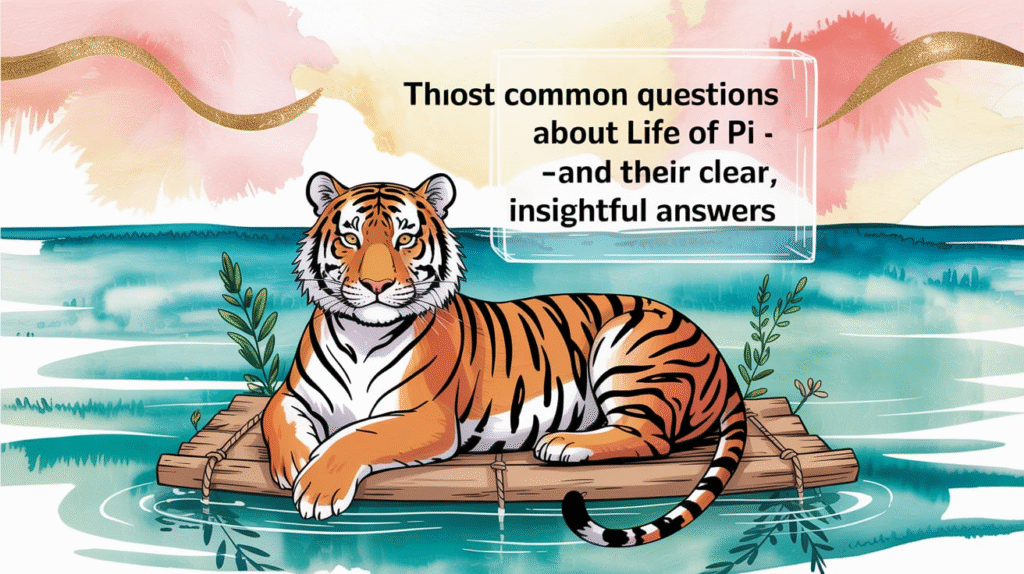The most common questions about Life of Pi revolve around its ambiguous storytelling, philosophical depth, and emotional impact. Whether readers are puzzled by the ending, intrigued by the symbolism, or exploring its spiritual undertones, Yann Martel’s novel sparks a wide array of questions, and interpretations.

This article answers the top reader questions to help clarify and deepen your understanding of the book.
What Is the Main Point of Life of Pi?
The novel’s central point is that storytelling and belief shape human experience more than objective facts.
It’s About Faith and Perspective
- Pi’s dual stories highlight how people choose to believe narratives that give life meaning—even in tragedy.
- The novel suggests that faith isn’t always about religion—it’s about choosing the story that sustains us.
Truth vs. Meaning
- The choice between the two stories is symbolic of the broader human experience: hard truth versus beautiful interpretation.
Is Life of Pi Based on a True Story?
No, Life of Pi is a fictional novel. While it’s narrated in a semi-autobiographical tone, it is not based on a real person’s life.
Inspired by Philosophical Questions
- Martel wrote it to explore belief, narrative, and survival, not to document an actual shipwreck.
- The story’s frame—an author hearing Pi’s tale—is fictional and serves as a narrative device.
Literary Invention
- The book blends realism with allegory, magic realism, and spiritual metaphor. Its truth is emotional and philosophical, not historical.
What Does Richard Parker Represent?
Richard Parker, the Bengal tiger, represents both a real threat and a deeper psychological metaphor.
Survival Instinct and Fear
- Richard Parker symbolizes Pi’s animalistic drive to survive. Training the tiger also means Pi is managing his own primal fears.
- Without Richard Parker, Pi might not have remained vigilant or mentally strong.
Projection of Trauma
- Some interpretations suggest the tiger is a psychological projection—representing Pi’s inner trauma or darker self during his survival.
Why Are There Two Versions of the Story?
The two stories (one with animals, one with humans) challenge readers to decide what they believe—and why.
Story as Interpretation
- The animal story offers symbolic distance from the brutal truth. The human story is bleak but more factual.
- The book invites you to choose the version that best reflects your worldview.
Commentary on Truth
- Martel argues that stories are how we process truth. Facts alone aren’t enough—meaning matters.
Why Did Pi Practice Three Religions?
Pi believes that God can be reached through different paths. His devotion to Hinduism, Christianity, and Islam reflects his open heart and spiritual hunger.
A Tribute to Religious Coexistence
- The novel respects all three faiths and portrays Pi’s spiritual journey as deeply sincere.
- It challenges the notion that one must choose a single belief system to have faith.
Faith as a Personal Journey
- Pi’s spirituality is not about doctrine—it’s about connection, devotion, and wonder.
What Is the Significance of the Ending?
The ending poses a choice between two stories, and it leaves interpretation up to the reader.
Reader’s Choice Reflects Their Belief
- Which story do you believe? Your answer reveals your approach to life, truth, and spirituality.
- It asks: Do you need hard proof, or are you willing to believe in something bigger?
Philosophical Closure
- The ending does not wrap things up neatly—but that’s the point. It reinforces the novel’s central message: belief is a choice.
Is Life of Pi a Religious Book?
Yes and no. It’s spiritual rather than doctrinal, exploring belief through storytelling rather than preaching any one religion.
Faith as Metaphor
- The story uses religious symbols and narratives to explore human resilience and the need for meaning.
Open to All Readers
- You don’t have to be religious to appreciate the novel’s depth. It speaks to existential, emotional, and ethical themes everyone can relate to.
FAQ: Questions and Answers About Life of Pi
Here are some questions and answers about Life of Pi that readers often search for.
What genre is Life of Pi?
It’s literary fiction, with strong elements of magical realism, adventure, and philosophical inquiry.
Is the island real in Life of Pi?
The carnivorous island is most likely a hallucination or metaphor. It represents false comfort or spiritual stagnation.
How old is Pi in the book?
Pi is 16 years old when the shipwreck occurs. The story is told by an older Pi looking back on his youth.
Why is the book called Life of Pi?
“Pi” symbolizes complexity and continuity. It also reflects the character’s inner journey through faith, science, and survival.
Who are the other animals on the boat?
The zebra, hyena, and orangutan are symbolically linked to the other human survivors. They reflect the real version of the story Pi later reveals.
Yann Martel’s Life of Pi is more than just a survival tale—it’s a mirror that reflects the reader’s own beliefs about truth, God, and the stories we tell ourselves. These questions show that even after the last page, the journey continues in the mind of every reader.
